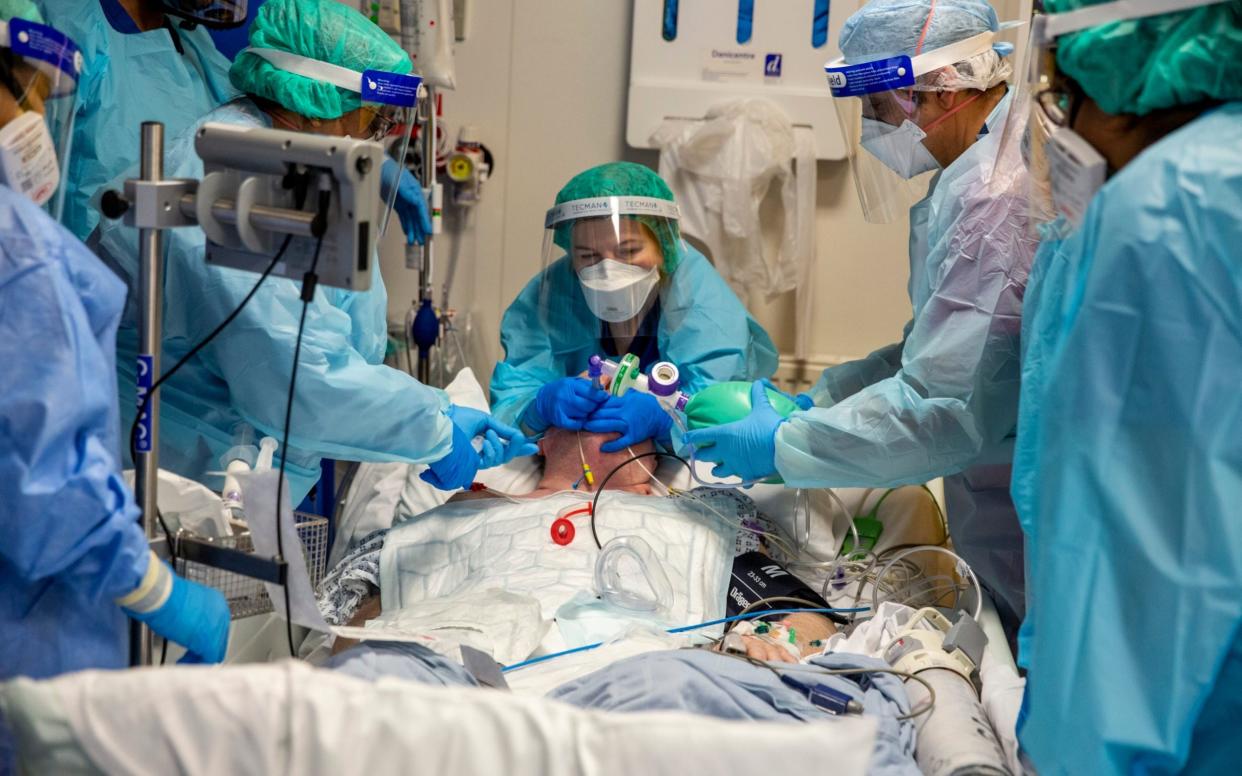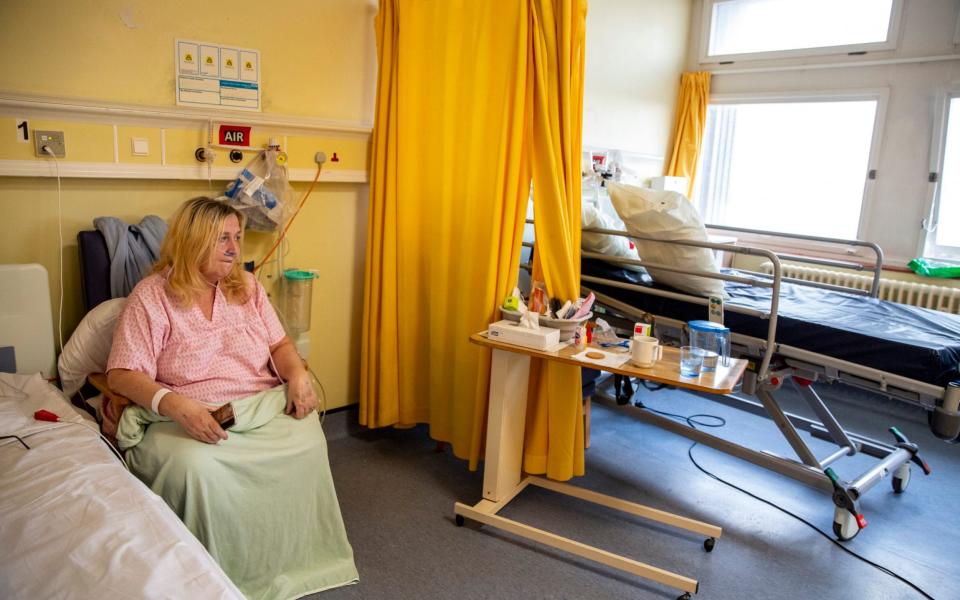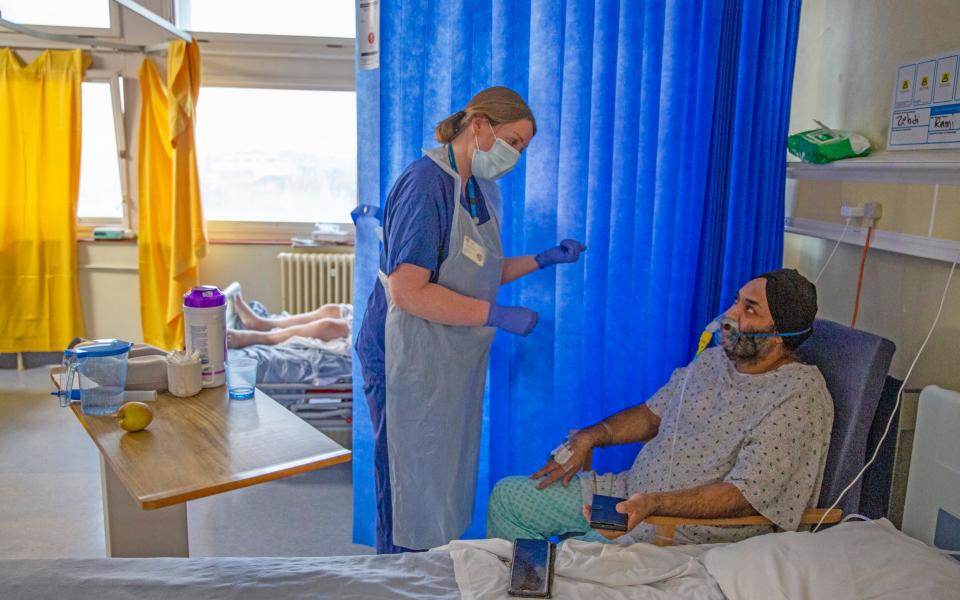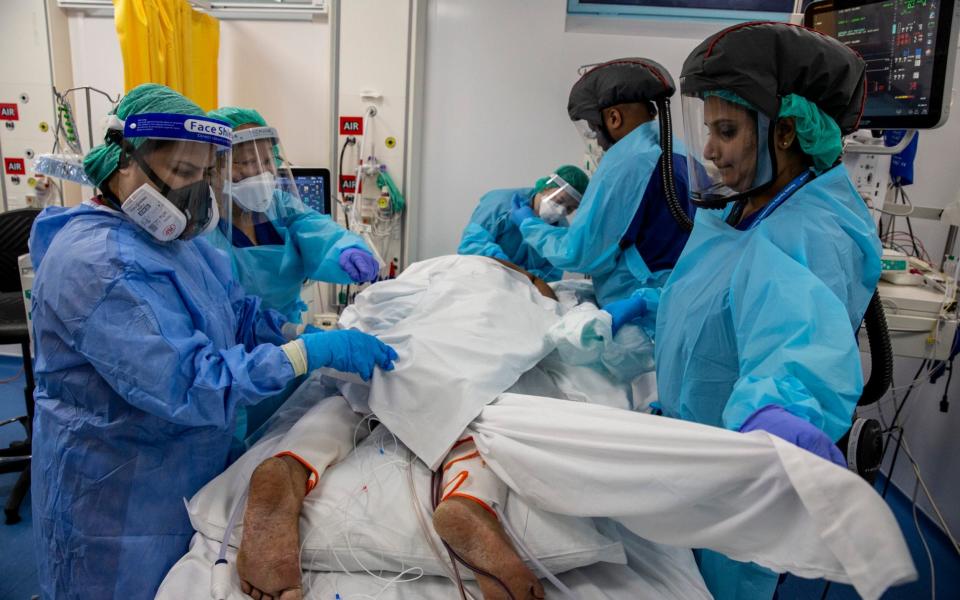I told the woman in the next bed she'd be OK – she died hours later

Elisabeth Cook is sitting up in a chair next to her hospital bed for the first time in ten days. Frail and exhausted, with a nasal cannula still supplementing her oxygen, she looks over to the bed next to hers which now lies empty.
“She died a few hours ago,” she says. “Last night she said to me: ‘I’m dying’, and I said ‘no, you’ll be ok’. She was like my mum, an old lady.”
A 56-year-old teacher, Cook tested positive two weeks ago. She felt a little unwell, she says, then “boom, the next thing you know I’m at death's door, rushed in, collapsed, couldn’t breathe”.
Cook has now been on oxygen for ten days, at one point receiving what’s called CPAP – Continuous Positive Airway Pressure. Less invasive than ventilation, but still undoubtedly gruelling, it involves wearing a mask that keeps the patient’s airways open. “I’ve been extremely unwell,” she tells me. “I was on the high dependency unit, unable to breathe by myself.”
Watch: UK Covid Deaths Surpass 100,000
Of the many people who have been wheeled into one of the seven Covid wards at Ealing Hospital over the past two weeks, Cook is among those that have turned a corner. But after a traumatic few days, and given everything she has witnessed from her hospital bed, she is still apprehensive. “Honestly [the treatment] it’s like torture, something out of the dark ages, it’s so frightening and people think it’s not real,” she says.
“The staff were amazing, but it was so, so frightening. I can’t believe that people think that it’s not real, people are still out partying.
“I’m watching people dying around me, I’ve never encountered that in my life. If they could swap with me for two minutes.”
In the next bay along lies Matthew Messider, who is only 38. He has been in hospital since January 4th. “I thought it was just a cold and took a test on December 30th and got the result saying I had Covid, and then spent a few days at home.
“Luckily enough I was speaking to a few family friends in the medical profession because I couldn’t sleep. I told them my lips were tingling and they said that was a strong sign I had low oxygen in my blood and from there I called an ambulance to get down here.”

He is still receiving round-the-clock care, but appears to be making progress. “There was a panic when there was no progression, the process of thought being the next step is the proper ventilator. That’s when the panic was kicking in.”
On ward six south, the high dependency unit, matron Gill Burnell says the average age of the patients in critical care during this wave has been strikingly different compared to the first. “At the minute we have a particularly young group of patients in,” she says. “Many of our patients on the very sick ward are now between the ages of 40 and seventy. For us that’s quite emotional because they’re often a similar age to us.”
Recovery times have also been notably longer during this wave, she says, meaning the demand for beds and pressure on the staff is much higher. “Normally pre Covid my respiratory ward has four enhanced beds for the sickest respiratory patients. After Covid we increased that to six and then in the autumn we went to eight. Now we’re on 18 to 19 and still looking to expand further. It's really hard work.”
Lliam Edger, a consultant in intensive care at both Ealing and Northwick Park hospitals, says this latest surge has confounded healthcare professionals in the way it has hit an entirely new rung of vulnerable people. “It may well have been that a lot of the very vulnerable got hit very badly in the first wave and didn’t survive that, and what you have now are the next rung who have comorbidities that make them vulnerable, but may not recognise that they are.
“They may be over weight or obese and that’s about it, and they get Covid.”
Watch: What is long COVID?
Edger is on an overnight shift in the ICU, where the tempo is notably different to the relative calm of ward six. Here, the sound of monitors never stops, and every patient is being kept alive by a mess of tubes. They lie slack jawed and unconscious, as staff walk calmly between beds administering medication to keep them stable. Doctors and nurses are in full PPE, wearing a long sleeved plastic apron, two pairs of gloves, an FPP3 3M respirator mask and visor over their regular scrubs.
As I arrive in ICU, observing from a distance, a patient has deteriorated and is being prepared for ventilation. A team of nurses surrounds the bed, overseen by an anaesthetist. Action needs to be taken quickly. He is losing oxygen fast.
The demographic of the patients in ICU is notable. They are all overweight – I’m told one weighs 150kg – making the task of turning them onto their fronts for a procedure known as proning (which helps to improve breathing and oxygenation in the blood) far more difficult.
It takes a team of five to prone one patient, and it’s a slow process, involving wrapping the unconscious patient in bedsheets and protecting them with a layer of pillows as they are gently rolled over, all while keeping their airways clear.

Victoria Marsland, the matron in ICU, is matter of fact about the situation, but says the flow of patients doesn’t show any sign of abating. “Critical care is currently over capacity with ten Covid patients all ventilated in intensive care.
“It’s been going on like this for the last few weeks. We’re still getting more. There’s a lag between lockdown and the amount of patients coming in to us. There is always a lag, because the disease process takes longer than the lockdown does.”
Dr George Hulston, a respiratory registrar, says what they are seeing now is worse than in the first wave. “The volume of patients in the second wave seems much higher, we’ve had more patients requiring respiratory support than we did in the first wave.
“I think the new variant has obviously contributed to that, certainly the biggest peak we’ve seen is the peak just after Christmas and the beginning of 2021.”
Back in ward six, Jasbir Singh, a 51-year-old electrician, looks older than his years. His eyes are tired and weary behind his oxygen mask, after spending the last week fighting the virus. “I came here on January 15, on the same day I had a walk in test over in Heston. By the afternoon my condition became a little more serious and I called A&E and I came here.
“The first day I was here it helped me but the next day it became more serious and they shifted me to a high dependency ward overnight.”
He is emotional, the trauma of the last few days having clearly taken a toll. “It was shocking as I hadn’t been anywhere, I was home for the last month, except I’d received a few food parcels. How did it come to me?”
He begins to cry, then dries his eyes and gives me the peace sign, determined to fight on.

Never Forgotten – Share your memories of loved ones you lost during the pandemic


